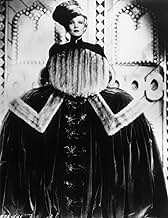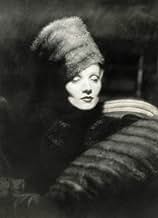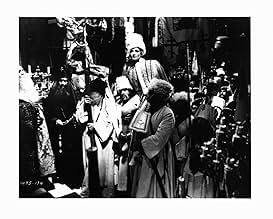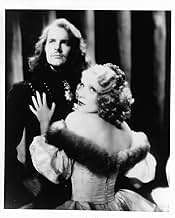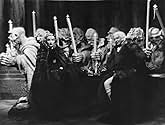Una nobildonna tedesca contrae un matrimonio privo d'amore con l'erede sciocco e degenerato al trono della Russia e poi complotta un modo per estrometterlo dal potere.Una nobildonna tedesca contrae un matrimonio privo d'amore con l'erede sciocco e degenerato al trono della Russia e poi complotta un modo per estrometterlo dal potere.Una nobildonna tedesca contrae un matrimonio privo d'amore con l'erede sciocco e degenerato al trono della Russia e poi complotta un modo per estrometterlo dal potere.
- Regia
- Sceneggiatura
- Star
- Premi
- 1 vittoria in totale
- Count Lestoq
- (as Phillip Sleeman)
- Ivan Shuvolov
- (as Hans von Twardowski)
- Sophia as a Child
- (as Maria)
- Lackey #5
- (non citato nei titoli originali)
- Count von Breummer
- (non citato nei titoli originali)
- Sophia's Aunt
- (non citato nei titoli originali)
Recensioni in evidenza
Director Josef Van Sternberg, dubbed (correctly) "A lyricist of light and shadow" by one critic, proves this point in "Scarlet Empress" more than in any other of his films. Sternberg also knew he was losing Dietrich, and I like one scene where an actor is made up (from a side view) to resemble Sternberg. This actor is essentially the only one Marlene refuses her bed to, despite having no qualms about bedroom antics with half the Russian court. Sternberg projected himself into the role of Count Alexi, a character who has more screen time than anyone other than Dietrich. Alexi is teased by Dietrich and in the end he, um "doesn't get the girl." Sternberg knew he was no longer getting Dietrich and put this knowledge on celluloid with an awe-inspiring, even malicious fire. There are two things in this film which I really LOVE. The grotesque replicas which saturate the film are of course indicative of how the film will play out. The replicas, I suspect, were not easy or inexpensive to make--which makes them all the more fascinating, horrifying and MESMERIZING!
The background score. I have never seen a drama from the 1930s which used music more brilliantly than "Scarlet Empress." In a scene in a stable, when there is a chance that the two principals may make love, they are interrupted by the braying of a horse, which had been out of sight of the two. (According to many historians, this scene has much, MUCH deeper significance than it seems.) I cannot write what the historians have told to me on this board. It would be inappropriate. But before the horse neighs in that scene, Dietrich is twirling from a rope, and the music in the background lends immense eroticism to the scene, as does a straw which keeps going into and out of Marlene's mouth. The music combined with the beautiful lighting is stunning! There is also an opening torture scene which features a man swinging to and fro inside a huge bell, his head causing the bell to peal. Then, a quick dissolve to an innocent young lady who is flying high on her swing. THAT is a feat of genius!
If you can ignore some historical inaccuracies, which I suggest you do, and allow yourself to gorge on the beautiful lighting, music, as well as most scenes, I dare you to tell me that the film didn't MESMERIZE you! A TEN!
This pre-Production code film is a treasure throughout
This was a movie about excess as much as anything, curtains that go on forever, huge doors, loud music, etc. They just don't make them like this anymore and certainly couldn't afford to then, either.
I don't think I ever saw Marlene anymore sensual than in this film, and I agree, her idea of playing a 'poor innocent gal'-that isn't put across well at all. Sometimes you just can't fake it, no matter how hard you try.
*** outta ****, style over everything.
All this takes form and depth, is sculpted by director Sternberg's haunting lighting. It is "his" light, he lords over it, and with it anything is possible. He can make a face beautiful or ugly, innocent or evil. He can accentuate a certain side of a person's nature, or how a specific set piece relates to it, all with the proper illumination.
If his lighting is astounding, equally so is Sternberg's use of the visual motifs in his mise en scene (bells, veils, figures, specific set pieces, etc...) to transport the viewer back and forth through the film. For instance, the binding of Catherine and Peter's hands at their marriage is later echoed by an unquestionably similar knot Catherine ties in a napkin she is fondling, and then tosses onto the table of she and Peter's last meal together. The initiation of their marriage and the initiation of its end are in this way linked, and the audience is forced to take into account the changes in both their characters. Not only does the rhythm of these motifs remain figurative. The movement of the film takes on a distinct rhythm as well. A swinging motif is evident throughout, the bells, the incense burners, Catherine's swing, the hoopskirts, a baby's basket, and so on. In this the film takes the feel of a frenzied, but excellently choreographed dance.
But in all this there is one thing more noteworthy. Marlene Dietrich radiates! Quite possibly the most beautiful woman who ever lived, she begins innocent and virginal (seemingly intentionally melodramatically), standing out in a world of amorality. She is both the happiest and saddest point of the film. Her wedding to the vulgar Peter in an immense, yet claustrophobic cathedral is the most emotional part of the film. As it is filmed entirely in a series of close-ups of individuals, and long shots that blur their faces, there is no discernible eye connection between any of the characters. She is completely alone. As a voyeuristic camera cuts closer and closer to her trembling, veiled face, we suddenly feel the need to turn away. We know now that this last thread of decency is about to be crippled. Soon enough her innocence begins to fade before her sexuality, and the surroundings that once nearly suppressed her, she lords over, a queen of immorality.
"The Scarlet Empress" expresses the essence of film, and why it succeeds as an art form. It creates the possibility of a world almost wholly artificial, divorced from anything that ever was. It retains only fragmentary reproductions of something that existed in a pre-filmed state, combining and distorting them to effect something 90% fake. What's more that seems all it is interested in. No other artistic medium (aside from painting) is viewed worthy of its visuals, and all theatrical, literary, or other requirements are given little attention. They are flippantly thrown in only to please a narrow minded audience, and occasionally (but very, very rarely) to accentuate the films themes. Yet painting, ah yes, painting. That was a medium worthy of a brilliant visionary like Sternberg, and one he transferred to the screen with gusto. "The Scarlet Empress" is to Dali in its obsession with the bizarre, da Vinci in its detail, Picasso in its complexity of associations, but entirely Sternberg in its conception.
Lo sapevi?
- QuizMarlene Dietrich's own daughter Maria Riva portrayed young Sophia at the beginning of the film and it was her debut in movies.
- BlooperMost of the action takes place at The Kremlin in Moscow. The historical Empress Elizabeth, Grand Duke Peter and later Catherine spent most of their reigns in St. Petersburg, which during the 18th Century was a modern, Europeanized city.
- Citazioni
Grand Duke Peter: Why are those bells ringing?
[He opens the bedroom door and addresses a man in the hall]
Grand Duke Peter: Why are those bells ringing?
Capt. Gregori Orloff: I don't know, Peter.
Grand Duke Peter: How dare you address me like that! Who are you?
Capt. Gregori Orloff: My name is Orloff, and I'm on duty as guard.
Grand Duke Peter: I'll have your head for this insolence! You're addressing the emperor!
Capt. Gregori Orloff: There is no emperor. There is only an empress.
- ConnessioniEdited from Lo zar folle (1928)
- Colonne sonoreSymphony No.4 in F Minor, Op.36
Written by Pyotr Ilyich Tchaikovsky
Excerpts played during the opening credits and incorporated into the score often
I più visti
- How long is The Scarlet Empress?Powered by Alexa
Dettagli
- Data di uscita
- Paese di origine
- Lingua
- Celebre anche come
- The Scarlet Empress
- Luoghi delle riprese
- Azienda produttrice
- Vedi altri crediti dell’azienda su IMDbPro
Botteghino
- Budget
- 900.000 USD (previsto)
- Lordo in tutto il mondo
- 3353 USD
- Tempo di esecuzione
- 1h 44min(104 min)
- Colore
- Proporzioni
- 1.37 : 1


